- Submissions

Full Text
Novel Research in Sciences
Continuous Improvement of the Quality of Neonatal Care based on “Supportive Supervision” Principle
Mikailova ZN*, Rzayeva LA, Aliyeva GC, Smirnova EE, Smirnova EE, Dadashova DT, Gulamova SR, Xalilova GE and Ejderova BT
Scientific Research Institute of Obstetrics and Gynecology, Baku, Azerbaijan
*Corresponding author:Mikailova ZN, Scientific Research Institute of Obstetrics and Gynecology, Baku, Azerbaijan
Submission: September 09, 2020;Published: March 26, 2021
.jpg)
Volume7 Issue1March, 2021
Introduction
Mother and child health is at the core of the public health system’s focus. Maternal mortality and morbidity depend on many factors, including the quality of birth care and neonatal care services [1-4]. Quality indicators should be there to measure the quality of any service. An appropriate monitoring and evaluation system is essential to improve these indicators or to keep their condition at best. In recent years, the supportive supervision approach to improving medical services has been successfully applied in various parts of the world [1,3-5]. Under the ACQUIRE project, the COPE approach (by Engender Health) is adopted to implement the supportive supervision at the selected medical facilities of a few districts in Azerbaijan. The Ministry of Healthcare decided to test the supportive supervisory approach at the ten facilities in Baku. Integrating the current quality assurance system of medical services to the supportive supervisory principles would improve the quality of services related to birth care and neonatal care services. The Public Health and Reforms Center was appointed to run the project with the technical support of the State Institute of Obstetrics and Gynecology (IOG) and with the financial support of UNICEF. The project aims to test and implement supportive supervision principles at the ten maternity hospitals (within the city of Baku). Helping to Identify and to solve current problems in the quality of medical services, as well as guiding the Ministry of Healthcare to implement supportive supervision in the healthcare system, are also primary goals. Supportive supervision reflects the attitude and position. It is also a process that encourages employees to improve their professionalism, to work better, and to provide quality services. Audit control is usually shallow and punitive. It focuses on deficiencies, errors, and audits individuals, not the process. Thus, it is based on the past instead of the future. In comparison, supportive supervision concentrates on solving problems of staff by pushing and supporting the quality improvement process. It focuses on the process rather than individuals. As a result of supportive supervision, the staff participates in problem-solving, perceives a supervisor better, does not hesitate to identify problems, and actively gets involved in solving them. Employees are given opportunities to realize their potential.
Methods
Three working groups have been formed to work with institutions. Each group includes 1 Public Health and Reform Center (PHRC) and 2 Republic Maternity and Gynecology Institute (RMGI) (gynecologist and neonatologist) representatives. A 2-day training was organized for the working groups. Tools to implement the project were identified throughout the training program. A 1-day training program was conducted among managers and representatives of selected institutions to explain goals, objectives, and approaches of the project. (Table 1) shows the list of medical institutions involved in the research and the number of staff (according to each institution) who participated in the training program.
Table 1:Number of employees trained within the 12 months prior to the start of the project.
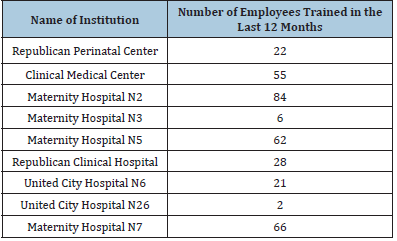
Factors that determine the quality of neonatal service are grouped under sections mentioned below:
1. The initial intensive care for newborn child
2. Maternal care for healthy newborn
3. Sustaining required thermal conditions.
4. Infection control
5. Feeding an ill newborn
6. Maternal care and treatment for an ill newborn
Visiting institutions started by meeting with managers. Managers were informed about the project and its working algorithm. In return, they briefed general information regarding their institutions. Coordinator and members of Continuous Improvement in the Quality of Services (CIQS) groups were identified according to the recommendation of managers. The groups were also informed about the project and its working algorithm.
Following approaches are used to determine the quality of services:
1. Talking to employees
2. Observations
3. Reviewing medical documentations
Data obtained through employee interviews, observations, and review of medical records is reported in unique forms. These forms reflect the quality of services that are based on WHO recommendations. The fill-out form consists of several sections, and each one presents several parameters for evaluation.
Values range from 0 to 3:
1. 0 - It isn’t implemented at all.
2. 1 - Significant improvement needed.
3. 2 - Little improvement
4. 3 - Fully implemented
The average value in the specific form is noted. The result of the evaluation is discussed with CIQS to identify current problems and their reasons. Two-three solutions, responsible employees, and deadlines are determined and recorded in the form of an action plan. CIQS has a copy of all the documents.
Statistics
The difference regarding quantitative indicators among groups was determined by the Mann Whitney U and Student t-test and differentiating the presence frequency of quality parameters among groups is identified by the Pearson X2 test. In all cases, if the difference among compared groups is p<0.05, then the result is considered to be statistically accurate.
Results
The main parameters that reflect the quality of neonatal care and the evaluation results of these parameters in the participating medical facilities vary from one to another. The initial evaluation values of facilities regarding the initial prenatal resuscitation are 0.8 and 2.4, and the last evaluation values are between 1.0 and 3.0 in (Tables 2 & 3). Clinical Medical Center (CMC) and Republican Perinatal Center (RPC) N 2,5,6,7 achieved significant improvement in the results. As seen from Table 2, it is obvious to feel the great need of improving the results for Baku City Hospital (BCH) N26, Republican Clinical Hospital (RCH), and Maternity Hospital (MH) N3. After reviewing results, organizing initial resuscitation for newborns and the training for the staff need to be advanced. Filling out medical papers is crucial in pursuing clinical research, analyzing & resolving errors, and developing the project. At the same time, in some cases, these documents would become helpful in protecting healthcare workers. Initial values of results in healthy newborns are 0.9 and 2.3, and final values range between 1.7 and 3.0 (Table 4 & 5). The dramatic improvement in this parameter was achieved by Maternity Hospitals N5, 6, 7. The main issues in this section are skin contact, early breast implantation, prevention of neonatal hemorrhagic disease, and training of mothers. As indicated in (Table 6 & 7), the initial evaluation results of the factors contributing to the thermal condition for the institutions are 0.1 and 2.4, and the final values are between 1.8 and 3.0. MH, CMC, RCH, RPC N1,5,6,7 was able to advance this department significantly. Additionally, there is a strong need for improvement in this index for MH N2 & 3 and BCH N26. Observing the thermal condition during the transfer of the infant and warming the child in hypothermia are primary issues in this section. Values regarding the results that control the infection are 0.5 and 2.2, and the final values range between 1.0 and 2.9 (Table 8 & 9). Maternal Hospital N5 & 7 achieved a significant upgrade in this index. Specifically, Maternal Hospital N3, BCH N 6, and RCH have weak infection control. Although BCH N 26, CMC, and RPM have achieved significant improvement, they should try to improve it even more. Most of the parameters in this section seem to require considerable progress. There is an urgent need to enhance hand-washing habits and infection control experience in addition to equipment-related issues. The initial values of the results that define the ill newborn’s feeding are 0.5 and 2.2, and the final values are between 1.0 and 3.0 (Table 10 & 11). MH and RPC N5 and 7 have serious progress under this parameter. Other facilities need to develop this index considerably. Although breastfeeding does not require substantial improvement, there are many problems related to it. In most cases, exclusive breastfeeding is disrupted, and breastfeeding in the initial phase is delayed. Lack of equipment, staff’s knowledge, and capabilities are principal problems of parenteral feeding. In (Tables 12 & 13), initial values of care and treatment for an ill newborn are between 0.3 and 2.0, and the final values are between 0.8 and 2.6. MH and RPC N5 & 7 have achieved essential advancements in this department. Other facilities require significant improvement regarding this indicator. Most of the factors that shape this unit urge considerable development as well. Staff seriously needs to be trained for the basics of care to newborns. In addition to the treatment of brain injury, the use of blood components, antibacterial therapy, and adequate medication use should be enhanced. There is a need to increase the capabilities of observation and laboratory-instrumental examination of an ill child.
Table 2:Parameters of initial intensive care for neonatal newborn.
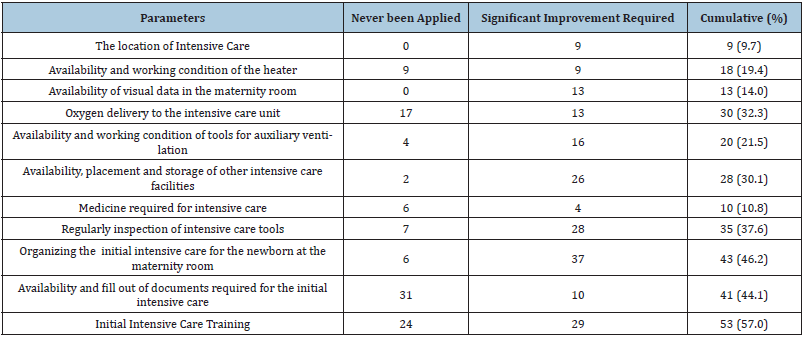
Table 3:Initial intensive care for a newborn.

Table 4:Parameters of maternal care for healthy newborns.
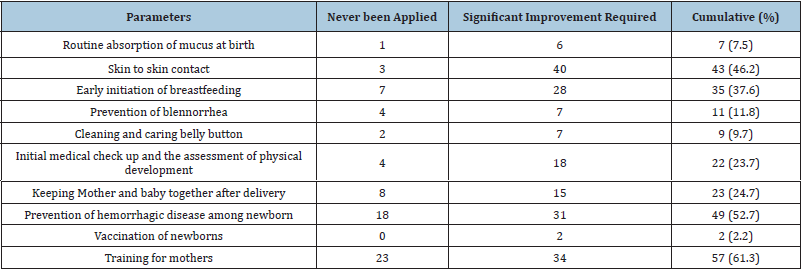
Table 5:Maternal Care for a healthy newborn.

Table 6:Parameters to sustain required thermal condition.

Table 7:Compliance with the required thermal condition.

Table 8:Infection control factors.

Table 9:Infection control factors.

Table 10:Parameters of feeding for a newborn with illness.

Table 11:Feeding a newborn infant with illness.
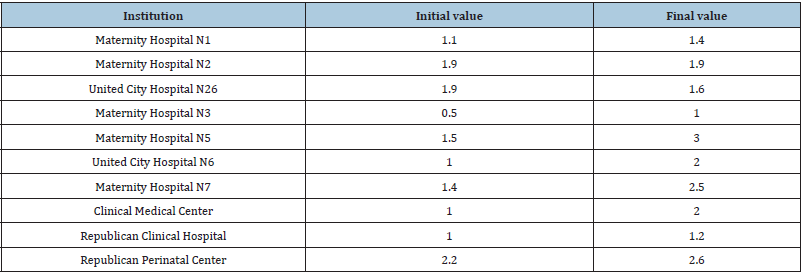
Table 12:Maternal care and treatment for newborn babies with illness.

Table 13:Maternal care and treatment for newborn babies with illness.
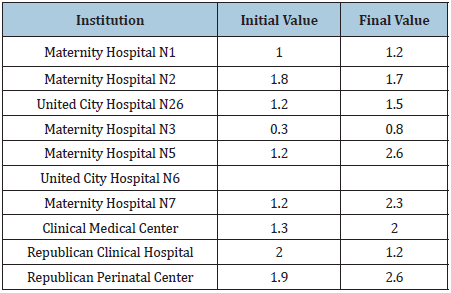
Discussion
Executing continuous development of supportive supervision and neonatal care projects for 11 months proves that selected tools to identify problems and solutions are useful.
During the supportive supervision project:
1. The staff is only responsible for identifying problems.
Members of the team from various levels participate in
researching the quality of services and solving problems.
2. A variety of sources enables us to obtain accurate
information. The multi-parameter service quality indicators
have been presented.
3. Obligations for the team, their deadline, and designated
people have been identified.
4. In most cases, service quality has been improved.
5. At the same time, there are objective and subjective
difficulties in troubleshooting as well:
6. Managers and staff lack sufficient knowledge regarding
the quality indicators.
7. Transferring modern knowledge and skills within the
institution is also weak.
8. In most cases, employees don’t approach certain factors
in a standard way. Personal stereotypes have an enormous
impact.
9. It is hard to resolve the issues related to stereotypes. To
overcome such problems, we need a continuous internal and
external audit as well as repetitive training for staff.
10. In other cases, managers’ instructions either detract
employees from providing modernized services or don’t
encourage staff to provide such services.
11. In many cases, clinical protocols, requirements of proven
medicine and the orders of the Healthcare Ministry are not
followed in daily practices.
12. Often, employee duties aren’t clear. Managers do not
regularly evaluate Their work. Employee incentives and
penalties are imperfect.
Although enough employees have attended training a year before the project, they still lack the knowledge and skills needed to address the existing shortcomings. The current improvement system is not related to the existing problems of the faculty. According to interviews with faculty managers, electricity and water supply are good enough. Some faculties have a satisfying heating system. Others supply it from the general system; therefore, heating shortages occur at a specified time. The problem requires an immediate solution.
The Ministry of Health has considerably improved the supply of equipment, drugs, and supplies in recent years. But there is also a need to improve the supply of other materials, medicines, and supplies. Some institutions don’t have acceptable laboratory services. After interviewing the postpartum woman and other individuals, we revealed that one of the reasons for lower early initiation of breastfeeding is poor skin contact. Another crucial reason is a false or incomplete guide regarding breastfeeding. Although breastfeeding does not need great improvement, there are many issues related to this matter. Exclusive breastfeeding is a problem, and mothers should be well informed. It is often disrupted, and breastfeeding is delayed. There are essential obstacles with parenteral feeding, both in the equipment and in the knowledge and skills of staff. There is an imminent need for educating staff about the basics of the care for newborns. The capabilities of observation and laboratory-instrumental examination of an ill newborn requires enhancement, specifically in the treatment of brain damage, the use of blood components, antibacterial therapy, and adequate use of drugs [6-10]. Managers should make more efforts to solve existing problems and improve the quality of services. They are also responsible for finding alternative ways to develop employees. At the same time, internal audit should be strengthened. Without any external help, some parameters (e.g., hand washing) can be improved in the short term. Steady progress in the quality of services should be a motivating and exciting factor for faculty managers and the staff [10,11]. Therefore, institutions and employees should be directly interested in improving quality. To sustain this, observation and evaluation systems of the Ministry of Healthcare and Baku General Healthcare Department must make substantial changes. Motivating initiatives are crucial for institutions and their staff with satisfying quality improvement. Along with financial support, transparency (availability of results to a broader audience) would also be an essential mechanism [12-15].
Conclusion
Thus, the result of the research shows that supportive supervision has a positive impact on improving the quality of services. Supportive supervision should be applied regularly, not on seasonal occasions. External, as well as internal audits, require the supportive supervision initiative. The results of such inspections should be available to a broader audience to create a competitive environment among institutions. Supportive supervision also helps to identify both biased and objective (non-facility related) factors that negatively affect the quality of services. Discussing objective factors at an intersectoral level and finding solutions to problems is necessary to improve the quality of services.
References
- World Health Organization (2003) Guide to producing national health accounts with special applications for low-income and middle-income countries. World Bank, United States Agency for International Development. Geneva, Switzerland.
- World Health Organization (2009) Guide to producing reproductive health subaccounts within the national health ac-counts framework. Geneva, Switzerland.
- Black RE, Allen LH, Bhutta ZA, Caulfield L (2010) WHO technical consultation on postpartum and postnatal care. Geneva, Switzerland pp. 1-65.
- Robert E, Lindsay HA, Ezzati M, Mathers C, Rivera J, et al. (2008) Maternal and child under-nutrition: global and regional exposures and health consequences. Lancet 371(9608): 243-260.
- World Health Organization (2010) Technical consultation on postpartum and postnatal care. Geneva, Switzerland.
- McCall EM, Alderdice FA, Halliday HL, Jenkins JG, Vohra S (2010) Interventions to prevent hypothermia at birth in preterm and/or low birthweight babies. Cochrane Database Syst Rev (3): CD004210.
- Bauer K, Uhrig C, Sperling P, Pasel K, Wieland C, et al. (1997) Body temperatures and oxygen consumption during skin-to-skin (kangaroo) care in stable preterm infants weighing less than 1500 grams. J Pediatr 130(2): 240-244.
- Baley J, Committee on fetus and newborn (2015) Skin-to-skin care for term and preterm infants in the neonatal ICU. Pediatrics 136(3): 596-599.
- E Hitt, P Murata (2006) New Guidelines for Pediatric and Neonatal Emergency Cardiovascular Care. Medscape Cincinnati, Ohio, United States.
- Ban K (2010) The global strategy for women’s and children’s health. New York, USA
- Conde AA, Belizan JM, Lammers C (2004) Maternal-perinatal morbidity and mortality associated with adolescent pregnancy in Latin America: Cross-sectional study. Am J Obstet Gynecol 192(2): 342-349.
- Cousens S, Blencowe H, Stanton C, Chou D, Ahmed S, et al. (2011) National, regional, and worldwide estimates of stillbirth rates in 2009 with trends since 1995: a systematic analysis. Lancet 377(9774): 1319-1330.
- Patton GC, Coffey C, Sawyer SM, Viner RM, Haller DM, et al. (2009) Global patterns of mortality in young people: a systematic analysis of population health data. Lancet 374(9693): 881-892.
- Say L, Doris C, Alison G, Özge T, Jane D et al. (2014) Global causes of maternal death: a who systematic analysis. Lancet 2(6): 323-333.
- UNICEF, WHO (2013) The World bank, united nations population division. The inter-agency group for child mortality estimation (UN IGME). Levels and Trends in Child Mortality, New York, USA.
© 2021 Mikailova ZN. This is an open access article distributed under the terms of the Creative Commons Attribution License , which permits unrestricted use, distribution, and build upon your work non-commercially.
 a Creative Commons Attribution 4.0 International License. Based on a work at www.crimsonpublishers.com.
Best viewed in
a Creative Commons Attribution 4.0 International License. Based on a work at www.crimsonpublishers.com.
Best viewed in 







.jpg)






























 Editorial Board Registrations
Editorial Board Registrations Submit your Article
Submit your Article Refer a Friend
Refer a Friend Advertise With Us
Advertise With Us
.jpg)






.jpg)














.bmp)
.jpg)
.png)
.jpg)










.jpg)






.png)

.png)



.png)






